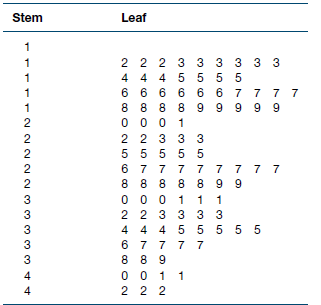Sometimes when we create a stem-and-leaf plot, we get too many leaves per stem to give a
Question:
Sometimes when we create a stem-and-leaf plot, we get too many leaves per stem to give a good representation of the data. In such a case, we can further split the data space for each stem equally. Suppose 100 CPA firms are surveyed to determine how many audits they perform over a certain time. In this case, the best representation of the data is given by splitting each stem into five ranges. This results in the stem-and-leaf plot shown. The first stem, 1, has been split into five, the first of which contains data in the range 10 to 11 inclusive (and there are no data points in this range), the second in the range 12 to 13, the third in the range 14 to 15, the fourth in the range 16 to 17 and the fifth in the range 18 to 19. Similarly, the other stems have been divided into five ranges. This method is similar to how we define intervals for histograms. What can you learn from this plot about the number of audits being performed by these firms?

Step by Step Answer:

Business Analytics And Statistics
ISBN: 9780730363330
1st Edition
Authors: Ken Black, John Asafu Adjaye, Paul Burke, Nelson Perera, Carl Sherwood, Saleh A. Wasimi





